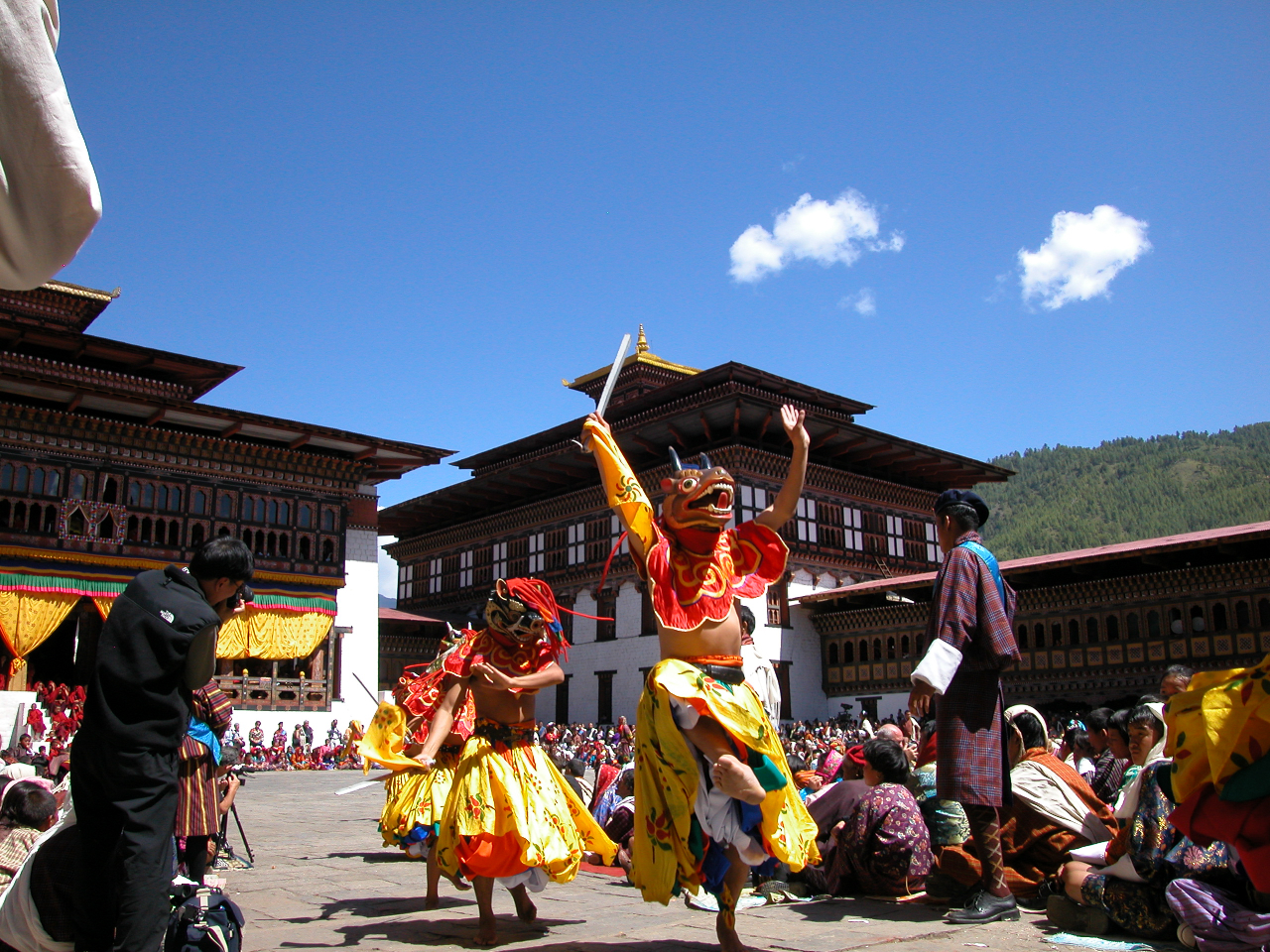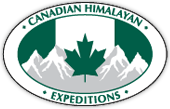Culture and Day Hikes
Map
This Bhutan adventure has the perfect balance of a combination of cultural touring and day hikes, but no overnight camping in tents (unless you really want that!;-). The country’s most interesting sights will be explored, but you will also enjoy ‘soft adventure’ on the active component that involves spectacular days hikes that are off the beaten path!

Kevin Grange has written a wonderful book chronicling one of our treks in Bhutan:
Detailed Itinerary
Thimphu valley and environs
Drive to Thimphu which is two hours away. In the first phase we drive from Paro to Simtokha. En route we pass the Tamchog Lhakhang built by Thangtong Gyalpo (iron bridge builder-a saint from the 14th /15th century who introduced the art of building suspension bridges with iron chains). There's an orange tree which fruits in the courtyard due to the blessings of the saint and monastery (oranges are not native to that region). We pass Chuzom (Meeting of the rivers or confluence). Bhutanese believe that evil influences gather at such places and hence three shrines have been built on this spot. The shrines have been built in three different styles- Nepali, Tibetan and Bhutanese. Vehicles need to register with check post at point.
The next part of the drive which is only 15 minutes is from Simtokha to the capital town of Thimphu where we will be staying for the next three nights.
Thimphu: Lying at an elevation of 2320m above sea level the capital of Bhutan is a blend of the traditional and the modern. It is the only capital in the world without traffic lights relying instead on the elegant gestures of the traffic policemen. The population of Thimphu is only around 40,000. Geographically speaking, the capital lies in a valley surrounded by mountains with the Thimphu River running through it.
Schedules are built around specific tastes of guests, and you are encouraged to discuss the itinerary with your guide and customize things to your personal preferences.
Sightseeing of Weekend Market. The bustling weekend market where all Bhutanese buy their groceries etc. also houses a handicraft section. Other sites time permitting, one of which should be the School of Arts and Crafts. Traditionally there are 13 arts and crafts in Bhutan. The students sell the works in a shop nearby to supplement their income. The 13 arts and crafts are Painting, Carpentry, Carving, Sculpture, Casting, Blacksmith, Bamboo works, Gold Smithing & Silver Smithing, Weaving, Embroidery, Masonry, Leather works and paper works. Guests can visit the school to see the students master the crafts. Visit local emporium and handicrafts shops in the town.
Additional sightseeing at the Folk Heritage museum which documents traditional life in Bhutan. The indigenous hospital uses age old Buddhist techniques to heal and offers a tour of its premises. The wonder herb cordycep has deep popularity in eastern remedies.
The Changangkha monastery offers a bird’s eye view of the valley and is also the guardian monastery of the valley. A round of golf can be arranged (nominal fees to be paid directly) for those interested. Time magazine has featured the picturesque golf course set near the house of government as one of the most interesting courses in the world.
Hike Suggestions:
Each of the valleys affords plenty of opportunity for hiking. In discussion with your guide and depending on the level of fitness one can choose from numerous options: In Thimphu hikes can be arranged to:
-The tango and cheri retreat monasteries (mid level).
-Phojoding lakes (demanding),
-Talekha monastery (demanding)
-Wangdiste monastery (gentle)
1 -4
Punakha/Wangdue valleys and environs
The last part of the journey is downhill to Punakha valley. En route we pass prayer wheels which are run by flowing water.
Guests can hike on the dochula trail (located at dochula pass) which is located within the botanical garden which holds many species of Himalayan flora and fauna. The park was established some years ago to protect the biodiversity within the region.
Punakha was the old capital of Bhutan and the magnificent dzong is situated on an island in the middle of the river. It is also the winter residence of the Central monastic body. It is a climatically a warmer valley than Paro and Thimphu.
We can visit the Punakha dzong and Short hike to Chimi Lhakhang where many go to pray for progeny. A visit to a traditional Bhutanese village can be arranged so that guests can view life in rural Bhutan. For those desiring more energetic pursuits – hiking to nearby villages can be arranged.
Visit the neighboring valley of Wangdue phodrang and the dzong which dominates the entry into central Bhutan.
-Khmsaum Yuelley Monastery ( easy to mid level)
-Chorten Nigpo (gentle to easy level)
-Chimi Lhakhang (easy – also accessible by road)
-Hiking along the old Gasa route (mid level- also requires some driving time). This hike is located in the Conservation park area.
-Along the Samtengang route (mid level)
5 - 7
Paro Valley and environs
Paro lies at an altitude of 2280m above sea level. Before the construction of roads most of Bhutan's trade came through Paro either from Tibet via Tremo la or from the south via Haa. Paro valley extends from Jumolhari on the Tibetan border to Chuzom which is the confluence of the Thimphu and Punakha rivers. Paro is a highly agricultural valley and the rice fields make a pleasant backdrop for the traditional buildings.
National Museum:
The National museum is located above the Dzong in the ancient circular watchtower. The museum consists of six floors dealing with different aspects of Bhutanese culture. The museum also houses a great collection of Thangkhas (embroidered or painted religious hangings). The Tshogshing Lhakhang (the temple of the tree of wisdom) is also located in the museum.
In the evening, stroll around Paro town to gain more insight into life in this part of Bhutan. The town is situated below the Dzong (fortress and monastery, which overlooks the valley) which is accessible via a traditional cantilever bridge. Near the bridge are chortens (or prayer shrines) situated alongside the Ugyen Pelri palace.
Day hike to the famous Tiger's Nest Monastery (Takstang) which is built where guru Padmasambhava is reputed to have flown to on the back of a Tiger!;-) The monastery is a revered site for the Bhutanese. The walk up to the viewpoint takes roughly two hours and is an uphill climb through alpine forests. (Riding horses can be arranged for a nominal fee if you prefer). Lunch is at a rustic trail-side lodge with a spectacular view overlooking the the monastery. The Tiger's Nest was partially destroyed in a fire about 10 years ago, but has been completely restored. The local people provided the labour for this as they believe that participating in the restoration of holy places helps in the accumulation of good merit.
Other activities include a selection of Cultural Sights in Paro:
Paro Dzong: The correct name of the Dzong is Rinchen Pung Dzong, which means fortress on a heap of jewels. The Dzong was built in 1646 by Shabdung Ngawang Namgyel. The Dzong was formerly the meeting hall for the National Assembly. The Dzong is located on a vantage point on the hillside and has two Lhakhangs (monasteries) and a Central Utse (Central tower). As with all Dzongs the local administrative and monk body are housed on the premises.
Choeten Lhakhang is a monastery situated in the centre of the town and is built in the traditional Bhutanese style. Dumtse Lhakhang is a temple believed to have flown from Tibet and is hence held by chains to the ground. Drive to Drugyel Dzong in the evening.
A pleasant 14-km drive from Paro town takes us to the site of the ruins of Drugyel Dzong. Drugyel Dzong was built to commemorate a Bhutanese victory over Tibetan invaders in the id seventeenth century. It is situated at the point where the trail form Tibet enters Paro. The Dzong was destroyed by fire in this century. On a clear day there is a magnificent view of the Mount Jumolhari form the site.
Hiking around Paro:
-Killey Goemba (demanding)
-Along Chelela ridge (mid level)
-Chelela to paro or Haa (mid level to demanding)
-Dzongdega (gentle to mid level) Optional day visit to Haa valley on day 9 or 10 which was only recently opened to tourism. Haa is a reminder of the Bhutan of yore and the drive to Haa is through Chelela which is one of the highest passes in Bhutan. The drive is magnificent and one can hike along the ridge at Chelela. Chelela pass is also the area where the national flower, the blue poppy, grows. Haa valley boasts lovely rural houses and untouched country side. The most revered temple is the temple devoted to the local deity Aup Chundu. Lunch will be arranged at one of the quaint local hotels. Development in this area is sparse, and that is good!
8-11
Depart Paro for home
Please note: You can customize your itinerary in discussion with your guide on arrival in Bhutan. A representative of our company will meet you on the first day to give you an orientation briefing and to co-ordinate your preferences or special interest with your guide, or you can have a plan laid out in advance from our staff in Toronto for the day hikes.
12
Synopsis
Trip Grading:

Length: 12 days
Max. Altitude: 3,100m/10,000ft
Begins and ends In Paro - Any date you wish
Land Cost: $3,950 USD (Customized private trip). Everything included except flights to/from Bhutan.
International Airfare: Approx $1400 USD from most cities to Bangkok (a Druk Air gateway city.)
Custom private departure at any time with as few as two people!
You can also contact Canadian Himalayan Expeditions directly for more information.
Synopsis
Trip Grading:

Length: 12 days
Max. Altitude: 3,100m/10,000ft
Begins and ends In Paro - Any date you wish
Land Cost: $3,950 USD (Customized private trip). Everything included except flights to/from Bhutan.
International Airfare: Approx $1400 USD from most cities to Bangkok (a Druk Air gateway city.)
Custom private departure at any time with as few as two people!
You can also contact Canadian Himalayan Expeditions directly for more information.





